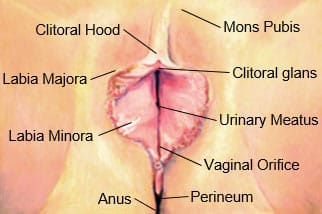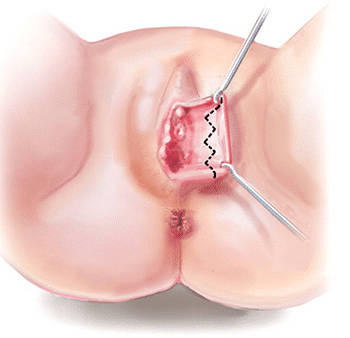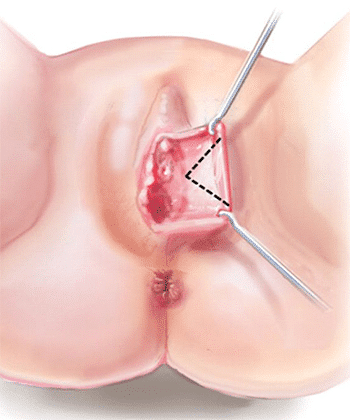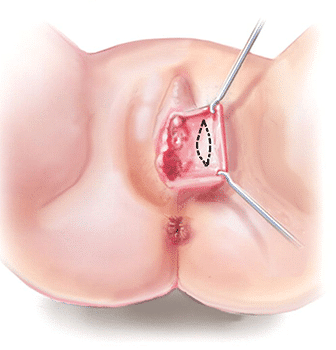Labiaplasty is the removal of some of the labia majora or minora – the outer or inner lips of the vulva.
Labia minora reduction or augmentation is by far the most common of the two procedures, as the labia minora by nature protrude from the labia majora, however labia majora reduction or augmentation procedures are also increasing.
This growing surgical procedure is most often cosmetic in nature, but historically has been done for functional reasons, for example, the labia may be causing a problem with hygiene, interfering with sex, sagging or drooping after weight loss or childbirth, or discomfort due to clothing or movement.
Labiaplasty is being performed more often now for aesthetic reasons to improve self confidence and reduce feelings of shame and embarrassment1. This fashion of the last decade or so is likely directly related to the Brazilian-style completely hairless vulva has made clear what lies beneath and media (magazines, porn) editing images to show only one main type of vulva: the single crease with very small or only slightly visible inner labia showing.
If you are wondering if this surgery is for you, read on about the nuts and bolts and check out A serious chat about your flaps for a laugh and some perspective.
Things to consider before you get labiaplasty surgery
Expectations can really get in the way of a good labiaplasty, and you need to check yours. Surgery isn’t magic, and a vagina and vulva are still weird little beasts you may never like, with or without your labia interrupting your view of yourself from up high.
If you have problems loving yourself or having body confidence, address these before you get surgery2–4.
Risks – things can and sometimes do go wrong
There are a growing collection of women out there with seriously damaged vulvas from labiaplasty surgery; they have trouble having sex, they are in constant pain, and if they thought their labia was ugly when they went in, you should see it now.
It is estimated that up to two per cent of women who get this operation end up with chronic pain. That is, pain forever with no relief, no sex, a hard time walking around, and being on medication and possibly needing more surgery. Be clear about the risks.
But most people are satisfied with their labiaplasty surgery5
Research6,7 shows that typically over 90 per cent of those undergoing a labiaplasty are moderately or very satisfied with their procedure.
Choosing a labiaplasty surgeon
Don’t underestimate the value of a good surgeon
If you don’t feel comfortable, haven’t seen plenty of pictures of his or her work, and know how often they have performed the surgery, find someone else. It is unwise to choose a surgeon because they are cheap.
You need to interview your surgeons; they are not doing you a favour – you are paying them very well for them to do a good job and the job that you asked for. Do your homework because your happy, confident, sexy life depends on it.
Cosmetic surgeons can have some very barbie-doll-esque ideas about what they think is ‘beautiful’ and ‘perfect’ and while you are knocked out on their operating table, you can’t argue. Beware. Look at pictures with your surgeon, and get your request in writing so you have some legal recompense if they botch it.
Questions worth asking
How old are you?8
It can pay to wait a little while until you are older, since your vaginal tissue may still be growing and changing. Don’t rush into it. Try being ok with it for a while.
After 25, you are in a better position physically and mentally to make a clear choice. Your views on what’s ok change a lot during those years, so talk about it with friends, do your research, and then just push pause for a bit.
Why are you getting this done?
There are generally three main reasons for labiaplasty: sexual confidence (i.e. men will like it better), physical discomfort, and medical reasons.
- If you think sexual partners don’t like labia, do your research, don’t make assumptions.
- If your labia gets stuck in your undies and causes you discomfort or pain, a trim may make life much easier and more comfortable.
- Sometimes medical reasons like disease or accidents mean a labiaplasty is the best way forward.
- And, of course, if you really hate your labia, go for it! Whatever makes you happy.
Practical Labiaplasty Matters
Be very clear how much tissue you want off
Having your whole inner labia cut out (amputated) while you are unconscious because your surgeon “prefers it like that” isn’t ideal, but it happens.
Your labia minora exist for a reason, and that includes protection, and your lips provide sustenance for much-needed lubrication for sex. You probably want at least 1cm outside of the labia majora so you can wear tight pants and sexy knickers without just your raw mucous membrane being exposed to the world.
Also, the inner labia connect your vagina to your clitoris, so when you are doing the wild thing, the movement of a penis between your labia minora actually sets off your clitoris, helping you to achieve orgasm. You need some lips to do this. The labia are rich with nerve endings9.
The World Health Organisation (WHO) classifies excision of the labia minora as Type IIa female genital mutilation.
Be very firm on what you want your labia to look like after the scars have settled and the wounds have healed. Don’t think that less is more; it may not be.
Ask for a local anaesthetic so you are awake while it happens, can talk to the surgeon during the procedure, and they can explain what they are doing and double check things. It helps to feel connected to the procedure.
Check how long you will be drugged up on pain meds for – you may not be able to return to work immediately, as this procedure is agonising to heal from for many women (though some are walking around fine the next day – you won’t know if this will be you!). Sitting and walking may be a trial.
Have someone with you when you go into the clinic who can be your advocate. Surgery is really scary, especially on your vagina, and you might find you lose it a bit and aren’t thinking straight.
Make sure that person knows what is supposed to happen, and won’t be scared to ask questions. You should feel comfortable at all times, including afterwards, knowing that you were in good hands.

Your ‘diagnosis’
Medically, there is nothing anatomically incorrect or endangering about longer labia, and labia of all sizes are deemed to be normal variations of the female body.
However, now that everyone seems into it, they have renamed labia that extends out from the labia majora as hypertrophy of the labia.
They’ve even given labial hypertrophy grades, so if your labia don’t stick out at all, you are deemed to be a Class 1, whereas if your labia dangle down as far as your perineum, you are Class 4. The rest are in between.
Who can and can’t have a labiaplasty
- Surgery can be performed theoretically at any age on a healthy female, but for obvious reasons it isn’t usually considered until puberty when the labia goes from being that of a plump little girl, and into the developed vulva of a woman. Many surgeons like to wait until a patient is at least 18 years old and can give consent for the operation themselves, however operations have been performed on 14 and 15-year-old girls. Before age 18, a parent can provide consent on behalf of the teenage girl.
- Pregnant women should avoid this surgery until after birth due to surgical risks like infection and anaesthetic.
- If you have genital diseases, you may need to reconsider, but you can discuss that with your surgeon who will be better placed to advise you. This could include cancers, herpes outbreaks, and other conditions that might make your vagina prone to infection, extra painful, or dangerous to operate on.
- Smoking and poor nutrition are known to delay wound healing by restricting nutrient-rich blood and oxygen flow to healing flesh.
- You may be referred to counselling prior to surgery. Body dysmorphia is a common problem amongst women, and although this is a private procedure and the surgeon is unlikely to say no to you, it is important to have your emotional stuff sorted before you approach the knife.
- You must be able to tolerate anaesthetic.
- Realistic expectations are a must.
- It is best for hygiene and practical reasons to have surgery away from your period. It might even be wise to suspend your period artificially if, say, you are already on the pill by running pills together, until your labia is healed to avoid irritation. Speak to your surgeon and get recommendations.
The labiaplasty operation
The operation is reasonably straightforward, with several effective methods developed. The labiaplasty surgery involves general or local anaesthetic, dotted lines drawn by the surgeon, cutting in the particular pattern specific to the method being used, then being sewn up.
Then, healing begins.
Local anaesthetic is preferred by many surgeons, as it offers the patient a chance to participate in the process by being awake and can increase satisfaction – you don’t want to wake up and they’ve done the wrong thing: too short, too long, lopsided.
Local anaesthetic also reduces the cost – general anaesthetic requires an anaesthetist to be present, which costs a lot more, you must be driven home after the operation by someone else, and cared for, as general makes you woozy for a while.
Methods of labia minora reduction10



The first technique developed was the trim or elliptical or linear method (clip and snip), then came the wedge technique, which leaves the natural edge.11
The other alternative is called the deepitheliasation method, with this technique preserving the entire natural edge, unlike the other two.
Each has its place, and will be considered for the labia presented by your surgeon, including the option of a combination of all, since many labia are in fact asymmetrical.
The Trim Labiaplasty Method
The trim method involves amputation of the labia minora, the slicing off of the outer edge of the labia minora, leaving about 1cm from the edge of the labia majora.
The lips are clamped and then cut with a scalpel in a very quick operation. A thin scar is left on the edge of the labia minora, and leaves you with a scalloped edge after taking a year to fully heal and the scar to mature, especially if the zig-zag cut is used. (The zig-zag cut reduces scar tension.)
Local anaesthetic can be used, and the patient can be awake for the procedure.
The Wedge Labiaplasty Method
This method of labiaplasty takes a wedge or other shaped section of the labia out, preserving most of the natural edge of the labia minora. It leaves one very small horizontal scar on the labia where the two sides of the wedge are removed and sewn together.
This preserves a lot of the natural labia structure, while reducing surface area. This method has two variations, with one being the standard wedge, and the being the hockey stick wedge.
If labia are thick, this method is usually preferred. General anaesthesia is often required.
Deepithelisation and Laser Labiaplasty Methods
This method requires the cutting out of a section within the ‘wing’ of the labia. Lasers can be used to achieve the same end.12
Healing and scarring after a labiaplasty
Healing time is up to three or so painful months. Swelling is usually extensive, so use of your vagina is going to be very limited and painful, and you won’t see the final results until weeks and weeks after surgery.
Some women walk out of there with a smile and stitches, while others take months to heal. It can be frightening if your vulva takes a long time to heal, so keep in touch with your doctor, do as you are told and eventually you will recover.
It’s a huge trauma to your vagina, and it responds with swelling and bruising. Sex, tight clothes and tampons are banned for four weeks after surgery.
Your surgeon will see you one week after surgery to check healing, then again at four weeks. Unless something goes wrong after that, you’re on your own.
The main problem encountered after labiaplasty is actually dissatisfaction with the results, after all that, but over 90 per cent of those who undergo the procedure are happy with the result.
Smokers have a worse time, as the wound can fail to heal correctly, or it can open up again during healing. Dissatisfaction is reduced by using local anaesthetic so the surgeon and patient can talk during the procedure.
Things that can go wrong with a labiaplasty
Because labiaplasty is an elective surgery, it is not even required that the number of labiaplasty surgeries be recorded, let alone the number of labiaplasty-gone-bad.
It is considered an ‘unproven’ surgery, as it hasn’t yet been peer-reviewed. What this means is nobody has studied satisfaction rates, injury rates, and sexual and personal happiness after the procedure. In a nutshell, did you get what you paid for.
The risks of labiaplasty include:
- Infection which can lead to very painful redness, inflammation, bleeding, scarring.
- Nerve damage that changes the way you respond to touch – this can make your labia feel numb
- Blood-vessel damage – when you are aroused, your labia become engorged with blood. This surgery can interrupt that function, affecting your sexual response and pleasure.
- Scarring – this can not only look unattractive, but can easily reduce sensation – if you touch any other scar on your body, you won’t really feel anything at all, because scar tissue doesn’t have a very good blood supply.
Discuss the risks with your surgeon, talk about what he will be doing to reduce risks, and what would happen, if say something were to happen… Don’t let him or her off the hook.
Importantly, don’t take their word for it. They are not going to tell you the botch jobs they’ve done, the lawsuits they have against them, or how inexperienced they are.
Ask around, get recommendations by women who have had it done, and really seek out the best surgeon money can buy. It’s too important to scrimp on, in their experience or skill.
Labia majora surgery
The labia majora can become atrophied (saggy and deflated) and result in excess skin which can look droopy. This can be more pronounced if you have lost weight, as the labia majora are made from fatty tissue that increases in size the more fat you carry, therefore if you lose weight, like the rest of your body, the skin collapses a bit.
It can also happen from normal ageing and the results of pregnancy. The reasons for the changes in appearance are very different to the labia minora, and can be caused by a loss of deep skin fat, collagen degradation and result in changes from hormonal shifts.
Labia majora surgery can include fat grafting or surgical resection. If the labia majora is droopy, you can add fat to it with injections or plump it up with calcium hydroxyapatite.
If the labia majora would benefit from being restructured, a surgeon can also do this using some of the techniques used above for the labia minora surgery, namely the elliptical cut.
Other options include reducing skin or using radiofrequency heat. Recovery is more complex than for labia minora, and scarring can be more pronounced because the type of skin is different.
Your surgeon will discuss scarring with you before the operation.
A serious chat about your flaps – understanding labiaplasty
References
- 1.Sharp G, Tiggemann M, Mattiske J. Factors That Influence the Decision to Undergo Labiaplasty: Media, Relationships, and Psychological Well-Being. Aesthet Surg J. Published online February 18, 2016:469-478. doi:10.1093/asj/sjv270
- 2.Sharp G, Tiggemann M, Mattiske J. A Retrospective Study of the Psychological Outcomes of Labiaplasty. ASJOUR. Published online November 14, 2016:sjw190. doi:10.1093/asj/sjw190
- 3.Sharp G, Mattiske J, Vale KI. Motivations, Expectations, and Experiences of Labiaplasty: A Qualitative Study: Table 1. Aesthet Surg J. Published online February 23, 2016:920-928. doi:10.1093/asj/sjw014
- 4.Sharp G, Draganidis A, Hamori C, Oates J, Fernando AN. Beyond Motivations: A Qualitative Pilot Exploration of Women’s Experiences Prior to Labiaplasty. Aesthetic Surgery Journal. Published online April 17, 2023:994-1001. doi:10.1093/asj/sjad105
- 5.Qiang S, Li FY, Zhou Y, Cao YJ, Liu MC, Li Q. Long-Term Follow-up in Labiaplasty in 414 Women. Ann Plast Surg. Published online August 9, 2022:353-357. doi:10.1097/sap.0000000000003264
- 6.Sorice-Virk S, Li AY, Canales FL, Furnas HJ. Comparison of Patient Symptomatology before and after Labiaplasty. Plastic & Reconstructive Surgery. Published online September 2020:526-536. doi:10.1097/prs.0000000000007081
- 7.Sharp G, Tiggemann M, Mattiske J. Psychological Outcomes of Labiaplasty: A Prospective Study. Plastic & Reconstructive Surgery. Published online December 2016:1202-1209. doi:10.1097/prs.0000000000002751
- 8.Kalampalikis A, Michala L. Cosmetic labiaplasty on minors: a review of current trends and evidence. Int J Impot Res. Published online October 18, 2021:192-195. doi:10.1038/s41443-021-00480-1
- 9.Alter GJ. Commentary on: The Safe Labiaplasty: A Study of Nerve Density in Labia Minora and Its Implications. Aesthet Surg J. Published online March 29, 2016:710-711. doi:10.1093/asj/sjw035
- 10.Tepper OM, Wulkan M, Matarasso A. Labioplasty: Anatomy, Etiology, and a New Surgical Approach. Aesthetic Surgery Journal. Published online July 1, 2011:511-518. doi:10.1177/1090820×11411578
- 11.Zahedi S, Bhat D, Pedreira R, Canales FL, Furnas HJ. Algorithm for Trim and Wedge Labiaplasties. Aesthetic Surgery Journal. Published online February 16, 2023:685-692. doi:10.1093/asj/sjad033
- 12.Bizjak-Ogrinc U, Senčar S. Sutureless Laser Labiaplasty of Labia Minora. Sexual Medicine. Published online August 2, 2021:1-1. doi:10.1016/j.esxm.2021.100406

Get a fresh perspective with a qualified, experienced vulvovaginal specialist naturopath.
This product has multiple variants. The options may be chosen on the product page
The most comprehensive vaginal microbiome test you can take at home, brought to you by world-leading vaginal microbiome scientists at Juno Bio.
Easy-to-use BV and AV treatment program.

Promote and support a protective vaginal microbiome with tailored probiotic species.






